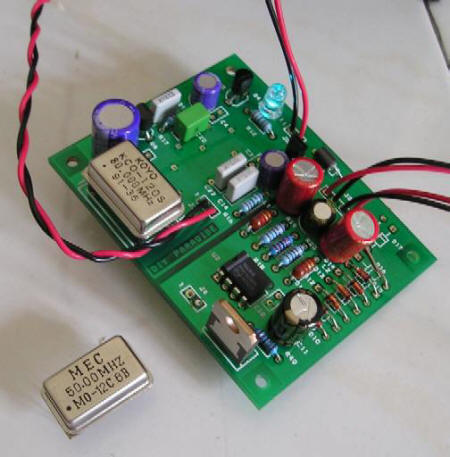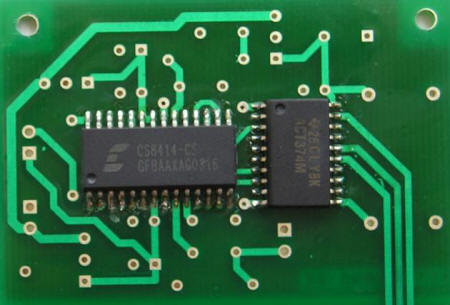|
You are reading the older HTML site
Positive Feedback
ISSUE
27
DIY
Paradise Monica2 DAC
The DIY Paradise Monica2 DAC is a non-oversampling 16-bit DAC with no digital filter and a passive output stage. It uses the ancient Phillips TDA1545A DAC in a very simple circuit and employs asynchronous reclocking. If you think all DACs sound the same, you really need to listen to a NOS (non-oversampling) DAC in your system. Any NOS DAC will usually provide you with a smoother, darker, and more relaxed sound than most other DACs that use a digital filter. The Monica DAC is a bit of a DIY affair even though you can buy the board fully stuffed and tested. Yeo, the DIY Paradise proprietor will sell you bare boards, stuffed boards, boards stuffed and mounted in boxes with all connectors, etc. I bought a stuffed and tested Monica2 after reading numerous rave reviews on the net. I also had experience with both the Nixon and Lite Audio DAC-AH NOS DACs. There are numerous implementations of NOS DACs but the Monica uses a single TDA1545A DAC chip and passive output stage making it one of the simpler designs (along with the Nixon, which is similar but uses the 1543 and no reclocking). Reclocking supposedly makes digital cable differences largely irrelevant. I canít verify that but I drove Monica directly from the digital output on my Squeezebox3 via a six foot Belden 1694A with Canare RCAP connectors. No problems here.
Monica can be powered by a 12V wall wart or a battery and after trying both, I prefer the silent background of the battery. The combination of non-oversampling and battery power supply will make most other DACs sound hard and bright in comparison. When you think about it, the DAC is one of the most important areas of the system for clean and stable power requirements. As the photos illustrate, I mounted Monica inside a Starbucks coffee tin and managed to include a 12V SLA battery and charger. Note that Monica is so small it could easily fit inside the chassis of most CD players. I wired a switch such that Monica is either powered on by the battery or the battery is being charged. Monica includes a blue LED that indicates a signal lock. Parts quality is very high including many boutique capacitors on board. I had no problems with Monica in my system but users should be aware that her passive output stage means a preamp might be required in most installations. Rather than the 2V output of most CD sources, Monica is closer to .8V so comparisons to standard DACs or CD players need to factor that in. The difference between my stock Squeezebox 3 output and Monica is dramatic, both in output level, tonal balance, and depth. All non-oversampling DACs in my experience sound darker and more relaxed compared to typical oversampling DACs. They tend to sound more organic, and analog. The flip side of these feature sets are that they tend to sound much less dynamic than "normal" DACs and CD players. Monica has the advantage over most of the DACs I have heard in that her midrange is gloriously warm, liquid, and seductive. Whereas the Nixon (1543 chip) and Lite Audio DAC-AH (8 x 1543) have good bass and smooth highs, they canít touch Monica in the midrange. And that is where most of the music is. Monica is scary transparent when playing acoustic guitars, voices, percussion, etc. Feed Monica to a good tube preamp and you know you are hearing something special.
One criticism that often is leveled at NOS DACs is that they sound congested when playing densely scored music. I didnít hear that for a long time but I am starting to believe there is a bit of truth in that. But it is not a major issue in my system and is more than outweighed by the midrange and top end superiority. In fact, if NOS DACs have a common flaw, I would offer that dynamics are their weakest feature. However, at the end of the day their dynamic compression is slight just as is their inability to articulate densely scored musical pieces. Monica handled every ultra-dynamic musical test I could throw at her and I never got tired of listening. I can listen to Monica for hours, all day in fact and never get a hint of listening fatigue. Monica tends to draw you into the musical performance and forces you to relax and enjoy yourself. If you donít experience this with your current digital rig, you just donít know what you are missing. One of my standard audio tests is Steve Hackettís (ex-Genesis guitarist) There are Many Sides to the Night CD which is a live performance in Italy with nylon guitar. The warmth and naturalness of that guitar recording never sounded better than through the Monica DAC. In addition, it struck me for the first time that during the song introductions between tracks where Steve talks to the audience, it finally sounded like a real voice, in a real three-dimensional space in my room. I have listened to this CD hundreds of times and I was surprised for the first time at the naturalness of the recording. Switching back to the stock Squeezebox (which has a very respectable analog output stage) the sound immediately loses a great deal of warmth and depth, sounds much harder in the upper midrange and downright bright in the highs. Listening fatigue soon wears me down and itís back to Monica. The Lite Audio DAC-AH may have the edge in powerful bass performance, but it canít hold a candle to Monicaís midrange and overall transparency. Ditto the Nixon DAC. Good but not great like Monica. Think midrange transparency and warmth. You can read a lot of technical jargon that tries to refute the NOS approach (as well as asynchronous reclocking) but your ears will tell you otherwise. On a price/performance scale, Monica is way out there on the bleeding edge and the popular DACs out there (read Benchmark, Lavry) do not embarrass her. I have taken the Monica/Starbucks DAC to many other audiophile systems and she holds her own with the latest DAC of the month. If you are looking for a fun DIY project, you canít beat Monica for the price. Although not a pure plug-and-play solution, you can order Monica in a configuration that only requires that the user find a decent 12V power supply. Yeo makes it easy and he has the right attitude for this hobby. Thanks to Yeo and DIY Paradise for adding some fun to my audio nervosa. Retail: $125 USD, although various options abound
DIY Paradise
|


